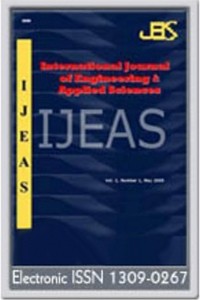Empirical Evaluation of Wet -Term of Refractivity in Nigeria
This paper presents the evaluation of the wet-term of the surface refractivity for twenty three sites in Nigeria carefully selected such that there is wide coverage for the country using ten-year data collected from Nigeria Meteorological Agency. The analysis showed that the southern sites have higher N-wet values compared to the northern sites. 50 % of the time, wet term refractivity is higher than 100 N-units in the southern sites. However, six out of eleven northern sites considered have values less than 50 N-units during the dry season
Keywords:
Refractivity, Wet term, N-wet, Nigeria Troposphere, Propagation,
___
- 1. H. V Hitney, J. H Richter, R. A Pappert, K. D Anderson and G.B Baungartner Jr. “Tropospheric Radio propagation Assessment, Proc.IEEE,73 (1985) 265-283
- 2. M. P. M. Hall, “Effects of the Troposphere on Radio Communication” Institute ofElectrical Engineers (1979).,
- 3. P. Valtr and P. Pechac, “ Tropopheric Refraction Modelling Using Ray Tracing andParabolic Equation, Czech Technical University in Prague, Czech Republic.
- 4. Anthony R.L., Chris Rocken, Sergey V. Sokolovskiy and Kenneth D. Anderson “VerticalProfiling of Atmospheric Refractivity from Groundbased GPS”. American Geophysical union (2002)
- 5. Steven M. Babin “Surface Duct Height Distributions for Wallops Island Virginia, 1985-1994. American Meteorological Society (1996) 86-93
- 6. Martin GRABNER, Vaclav KVICERA, “Refractive Index Measurement at TV-TowerPrague”. Radio Engineering, Vol. 12, No 1, (2003) 5-7
- 7. Pedro Garcia, Jose M. Riera and Ana Benarroch, “Statistics of Dry And Wet Scintillationin Mandrid Using Intelsat 50 GHz Beacon”, Cost 280 PMS-013, 1st InternationalWorkshop (2002)
- 8. Rec. ITU-R, “Propagation Data and Prediction Methods Required for the Design ofEarth-Space Telecommunication Systems” Rec. PN 618-7, InternationalTelecommunication Union, Geneva (2001)
- 9. Karasawa, Y; Yamada, M. and Allnutt, “A New Prediction Method for TroposphericScintillation on Earth-Space Paths”, IEEE Trans. Antennas Propagation, Vol. 36, (Nov.,1988) 1608-1614
- 10. Otung, I.E., “ Prediction of Tropospheric Amplitude Scintillation on a Satellite Link”,
- IEEE Trans Antennas Propagation, Vol. 44, (Dec. 1996) 1600-1608 11. Orgies, G., “Prediction of Slant-Path Amplitude Scintillations from MeteorologicalParameters”, Proc of int. Symp. on radio Propagation, Beijing, China (Aug. 1993)
- 12. ITU-R “Radio Refractive Index: its formula and refractivity data” Rec. P 453-9,International Telecommunication Union, Geneva (2003)
- 13. Otolia Croitoru and Marian Alexandru, “Propagation effects in GPS Accuracy. Theprecision Improvement of positioning in real conditions of Propagation”. Electronics.Sozopol, Bulgaria (2004)
- 14. Adediji, A.T., Ajewole, M.O., Fallout S.E and Oladosu, O.R,”Radio RefractivityMeasurement at 150m Altitude on TV Tower in Akure, South-West Nigeria” Journal ofEngineering and Applied Sciences 2(8), Medwell Journals, (2007) 1308-1313
- Başlangıç: 2009
- Yayıncı: Akdeniz Üniversitesi
